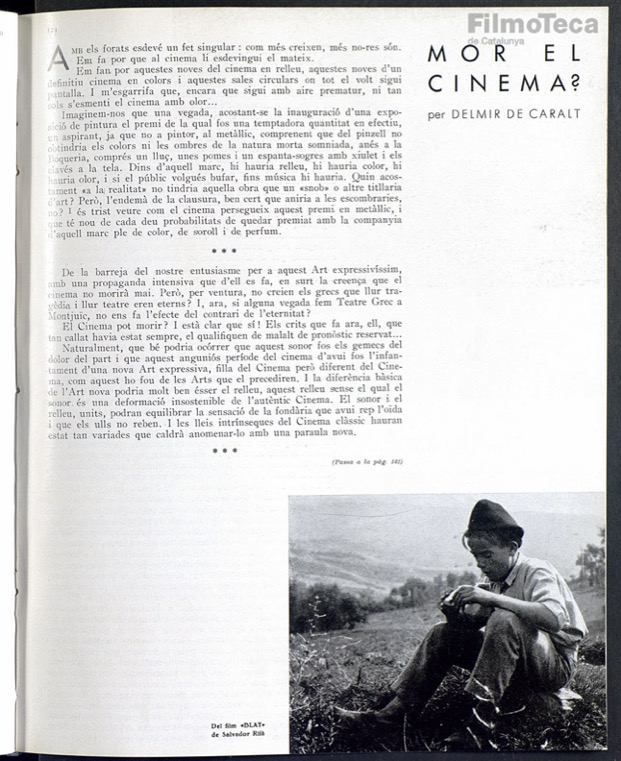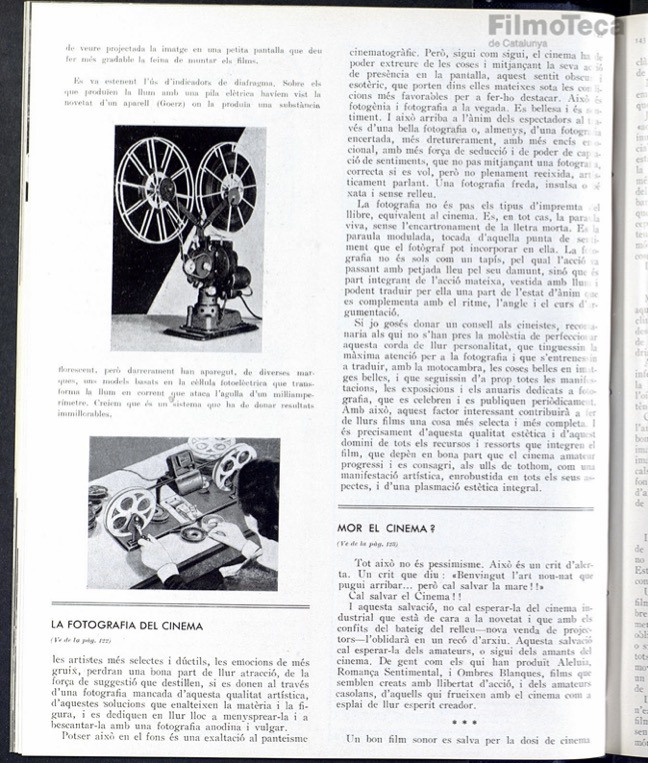Is Cinema Dying?
Delmiro de Caralt (translated by Enrique Fibla Gutiérrez)
Cinema Amateur 4, Winter 1933-1934, p. 121
Holes are a curious thing: the more they grow, the more they can become anything. I am afraid that the same will happen to cinema.
I am afraid of the novelties of a cinema in relief, in color, or in those circular rooms surrounded by screens. I am shaken by the fact that, although still rather inchoate, there are already mentions of odorous cinema.
Imagine that, for a painting exhibition where the prize is a tempting amount of cash, an aspiring artist, not even a real painter, realizing that from the paint brush he will not obtain the colors or the shadows of the dreamed still life, could go to the Boqueria market, buy a fish, some apples, a party blower, and a whistle and then nail these to the canvas. Inside this frame there would be relief, color, smell, and, if the public would choose to blow, even music. What approach to “reality” would this work have that a “snob” or any other person would call art? The following day it would surely be tossed into the trash, would it not? It is sad to see the way in which cinema chases a comparable cash prize, and that it indeed has favorable chances of attaining it – the frame full of color, sound, and perfume.
Given the combination of our enthusiasm for such expressive art and the intensive propaganda that accompanies it, I believe that cinema will never die. But did not the Greeks believe that their comedies and tragedies were eternal? And if we now see a play in the Greek theater in Montjuïc, do we not get exactly the opposite impression?
Can cinema die? Of course, it can! The noise it makes now, when it had always remained silent, makes cinema look like a patient with an uncertain outlook…
It could well be that these sounds are birth pangs and that this quivering period of cinema is just the infancy of a new expressive art, the daughter of cinema but different from it, as was the case with the arts that preceded it. The salient feature of this new art could well be its relief, the texture without which sound is an unbearable distortion of the authentic cinema. Sound and relief, together, could balance the sense of depth that our ears receive but our eyes do not fully grasp. The original laws of classic cinema would have changed so much that a new word would be needed to describe it.
All of this is not pessimism. It is a warning cry. A plea that says: “we welcome the arrival of this newborn art…but we must save the mother!!”
We must save cinema!!
Its salvation cannot be expected to come from a commercial cinema which depends on commodifying novelty, one which, with the new technical and commercial era afoot – characterized by the selling of ever newer and more novel projectors – will soon lie forgotten in a lonely corner of the archive. No, salvation will come from amateurs, that is, from the lovers of cinema, the DIY filmmakers, those who relish cinema as a space for their creative spirit. It will come from those who have created Hallelujah, Romance Sentimentale, and White Shadows, movies that seem to have been made with a true liberty of enterprise.
I believe that the amateur still has much to explore in the terrain of classical cinema before getting tangled with cinematic innovations created with purely commercial intent. The amateur, as an artist and as a creator, is vaccinated against a series of germs that affect commercial film production. And sound is one of them.
Today, the greatest filmmaker in the short history of the medium, Charles Chaplin, finds himself with the hindrance of sound, and it is to his displeasure that he sees how a silent film would be rejected and considered a relic. But the amateur, since he produces for himself and not for the world, is free to choose between making a film or making a rigid thing.
And he rejects sound.

